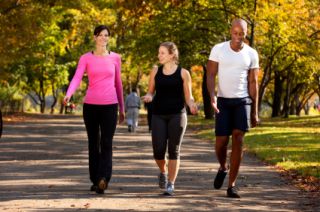When to Walk? Try After Meals Walk after meals. Stand and move after you eat. You've probably heard this advice somewhere. But does it really work? The Study They did it two different ways—for 15 minutes after meals, or for one 45 minute session in the evening. Both walking "interventions" improved glucose tolerance. People produced less insulin following the meal. Internal sugar levels were more balanced. And when people walked after the evening meal, instead of seeing sugars rise for hours and hours throughout the night, they came back to normal levels quickly. Just from a little bit of walking. The study conditions were stacked—people who already had moderately high glucose levels were the ones investigated. And the study size—though done with multiply repeated changes and measures—was only ten carefully followed subjects. Because they agree with a trend coming out of recent research—that even brief high glucose levels are bad for you—and can be prevented by rather minimal exericse. But they can be stopped—preferentially—by the simple action of walking after meals. When you walk after a meal you slow or even stop digesting your food. The sort of high glucose levels you normally get from malted milks, or snickers, candy, bread and cakes—and that occasional fast food sandwich. Add in that insulin production is heavily stressed by the modern American lifestyle—short nightly sleeps; processed meals; calorically dense foods; prolonged bouts of sitting. In other words, type 2 diabetics are producing huge amounts of insulin—but that insulin does not have the full chance to act. And there's more. A. If you walk after a meal you can cut back on esophageal reflux. That stomach acid can be ferocious. People with reflux have higher rates of esophageal cancer. B. You can obtain better weigh control. C. Walking immediately following the evening meal may yet more effectively control weight. That's particularly important to shift workers, who gain weight disproportionately by eating at times when others are resting or asleep. When you snack at night you need to get going—fast. Walking in light improves mood. Walking with friends increases social support. Walking in the evening can cut back on the frequent leg kicks that wake many folks all through the night, worsening their sleep—and making them hungrier come morning for fattier, sugary foods. Bottom Line Take a walk after meals. And using natural rhythms can make your body—naturally—feel and look better. M. D. Hegde
MANGALORE
Think Good Do Good
whatsapp number 90355 30833
https://www.facebook.com/groups/hegdemd
www.federationits.com www.keralites.net
Posted by: =?UTF-8?Q?=E2=99=A3_=E2=99=A3_=E2=99=A3M=2ED=2E_?= =?UTF-8?Q?HEGDE=E2=99=A3_=E2=99=A3_=E2=99=A3?= <hegde_csl@yahoo.co.in>
| Reply via web post | • | Reply to sender | • | Reply to group | • | Start a New Topic | • | Messages in this topic (1) |
To subscribe send a mail to Keralites-subscribe@yahoogroups.com.
Send your posts to Keralites@yahoogroups.com.
Send your suggestions to Keralites-owner@yahoogroups.com.
To unsubscribe send a mail to Keralites-unsubscribe@yahoogroups.com.
Homepage: http://www.keralites.net

No comments:
Post a Comment